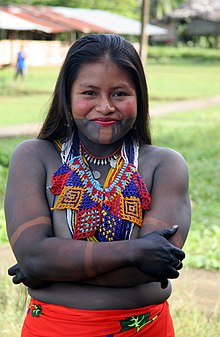Embera
The indigenous people of the Embera (Emberá) live in Colombia and Panama and belong to the Chocó language family . Embera is spoken by 60,000 to 110,000 people.
The people in Colombia are made up of the following groups:
- Embera del Baudo , Río Atrato , Juradó municipality , Chocó department
- Chami, on the upper reaches of the Río San Juan , Risaralda , Río Garrapata and Río Sanquinini in the Valle del Cauca , Cristiania and la Sucia, Antioquia
- Katio , northwest of Antioquia , Ituango , and on the upper reaches of the Río Sinú and Río Verde in Córdoba
- Eperara - Siapidara, on the Río Saija , in López de Micay , Río Cauca and Río El Charco , Río Olaya Herrera in Nariño and on the Río Naya , in Buenaventura in the Valle del Cauca
71,412 people live in the 79 Resguardos with an area of 1,497,134 hectares. These are distributed in the departments of Antioquia, Caldas , Risaralda, Valle del Cauca, Cauca, Nariño, Putumayo and Caquetá .
In Panama , about 7,000 Embera live in the autonomous indigenous territory of Emberá-Wounaan . Smaller groups live on Lake Gatun and the Río Chagres in central Panama. The Embera in Panama is also referred to as "Northern Embera" in the language classification.
tradition
According to their own tradition, the Emberá immigrated from the south. They lived semi-nomadically as hunters and gatherers in the high tropical rainforests of northern Colombia and Panama up to the border with Costa Rica. At the head of the tribes are an elected chief and a medicine man. After 1970 her lifestyle changed radically. Poor settlers pushed them out of their settlement areas, large-scale clearing, dams and nature reserves hindered hunting. The scattered Emberá families moved together in larger settlements.
At least among the Emberá-Chamí there is still a tradition of female genital mutilation . In 2012, a 15-day-old Emberá girl died after clitoral cutting in Ansermanuevo north of the Valle del Cauca (Colombia). The investigating authorities stated that one must respect the traditions of the indigenous people, but only within the human rights guaranteed by the Colombian constitution.
Current development
Since the 1980s, the Embera in Panama achieved semi-autonomous status in comarcas . Some of them have opened up to tourism, offer handicraft products, but stick to a natural way of life. In 1998 the Noanamá minority founded their own political organization.
The Colombian Constitutional Court banned Rio Tinto , Sunward and Muriel Mining Corporation from building a mine after militarization of the area and human rights abuses. It rejected the revision on March 9, 2012. from. The 2009 lawsuit by Embera and the Afro-Colombian communities in Jiguamiandó , Chocó was directed against Muriel Mining. In the course of its Mandé Norte copper-gold-molybdenum project, in which Rio Tino is involved, the group had failed to legally consult the affected communities in advance. The Colombian government had already signed this principle in August 1991. An interethnic council (Consulta Interétnica de los Pueblos) unanimously rejected the mining projects in 2009.
Web links
- Literature about the Embera in the catalog of the Ibero-American Institute in Berlin
- Travel report about the Embera
Remarks
- ↑ Colombia: Infant dies after circumcision. In: latina-press.com. Retrieved March 28, 2020 .
- ↑ Muere niña indígena por ablación de clítoris. In: caracol.com.co. Retrieved March 28, 2020 .
- ↑ Bebé indígena de 15 días de nacida muere por ablación de clítoris. In: vanguardia.com. Retrieved March 28, 2020 .
- ↑ Justification .
This article is based on the article Embera ( Memento from July 1st, 2010 in the Internet Archive ) from the free encyclopedia Indianer-Wiki ( Memento from March 18, 2010 in the Internet Archive ) and is under Creative Commons by-sa 3.0 . A list of the authors was available in the Indian Wiki ( Memento from July 1, 2007 in the Internet Archive ).


